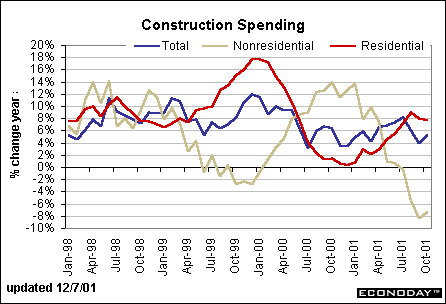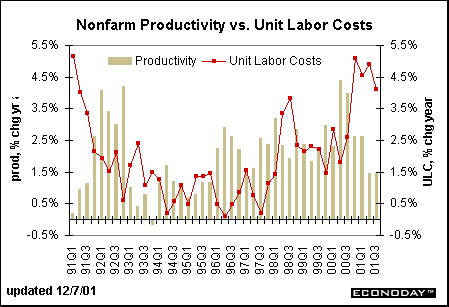
Nonfarm payrolls drop; unemployment rate rises
Nonfarm payroll employment declined 331,000 in November after a downward revised drop of 468,000 in October. September payrolls were
revised up to show a smaller decline. Economists were predicting a less severe drop - and many economists had revised their forecasts on
Thursday after seeing a further fall in continuing jobless claims.

The service-producing sector did show some improvement in November by posting a decline that was half as large as October's. However, the
goods-producing sector worsened. Mining and construction payrolls were virtually unchanged for the month, and not surprisingly, the
manufacturing sector showed continued deterioration. The drop in factory payrolls matches the downward trend in factory orders. In 1998 when
factory orders were showing a rising trend, it took a few more months to see a corresponding gain in payrolls. It is too soon to judge whether the
slight upward tilt in factory orders in October will continue and stop the bleeding of factory payrolls.

The civilian unemployment rate increased 0.3 percentage points to 5.7 percent in November. Household employment declined for the second
straight month, although like the payroll figures, the drop was not as large as in October. The jobless rate is a lagging indicator of activity, and
even when the economic recovery will begin next year, it is likely that the unemployment rate will worsen before it gets better. This happens
because people often leave the labor force when they see the unemployment rate rise, so they are no longer counted as unemployed. Yet, when
economic conditions improve, they re-enter the labor market and once again count in the labor statistics, pushing up the rate even when
employment increases.

Concerns over wage pressures are rapidly diminishing for the Fed. Average hourly earnings rose 0.3 percent in November, but are only 3.9
percent higher than a year ago. Notice that yearly earnings gains are moderating. This means that inflationary pressures aren't a worry and it
also helps reduce compensation costs for employers. However, lower wage gains are not good news for consumers who will have less
discretionary income to spend on goods and services.
The consumer: a mixed bag of tricks
Many people get frustrated with economic data because it often shows a mixed picture. The problem is not always with the data, but with
interpreting the data. For instance, we saw three different types of indicators for the consumer sector this week, but they didn't all cover the
same time frame. Personal income and outlays was reported for the month of October; motor vehicle sales were reported for November; and
consumer sentiment covered early December. The news won't be entirely consistent because the time periods are different!

Personal income was unchanged in October for the second straight month; that's not surprising given the drop in payrolls during September and
October. Disposable income (personal income less tax payments) fell sharply for the second straight month, but reflects the fact that the
government is no longer mailing out tax rebate checks. Indeed, the level of personal income was slightly higher in October than in June, but the
level of tax payments was lower in October, reflecting lower withholding schedules.
Personal consumption expenditures shot up 2.9 percent in October reflecting the surge in auto sales on zero percent financing. Spending on
nondurables and services was also up from September. Because the purchase of an automobile is counted as a sale in the month that it is
incurred and at the full purchase price, it causes a spurt in spending and a corresponding plunge in savings. The personal saving rate fell to 0.2
percent in October from 4.6 percent in September. In fact, consumers wouldn't have taken all their savings to finance a car. This is a peculiarity
of national income accounting. Another strong month of auto sales in November will also hurt the savings rate, but look for the savings rate to
rise again when the incentives are over.

Motor vehicle sales were healthy in November, although were down from extraordinary October levels. Many auto manufacturers' maintained the
special zero percent rate. While the advertising focuses on zero financing, it is useful to realize this applies only to 3-year loans. Longer loan
terms have higher financing rates.

While consumer confidence surveys should always be taken with a grain of salt, the early December reading is showing some minor
improvement. The consumer sentiment index stood at 85.8 in early December, up from 83.9 in November. Clearly, confidence has a long way to
go in order to get back to year ago levels. Confidence tends to move in the same direction, if not by the same magnitude, as retail sales and is
closely followed by bond and equity investors. The early December reading was bullish for equities because it showed signs of economic
improvement, but was bearish for bonds for the same reason. Bond investors prefer negative economic news so that Fed rate cuts can
continue.
Manufacturing & Construction
Factory orders jumped 7.1 percent in October, reversing September's 6.5 percent slide. Given that these orders were clearly affected by the
September 11 tragedy, the two-month picture is less useful than normal. On a year-over-year basis, new orders were still rather weak, although it
does appear that the year-over-year declines are getting smaller. November and December figures may be more useful in determining the
direction of this series.

The NAPM survey may give us a clue about the direction of production and orders for November. The diffusion index of overall activity increased
to 44.5, up from October's level of 39.8. In any case, the levels are still below 50 percent and reflect a contracting sector, but the rate of decline
has moderated and this bodes well for future months.

Incidentally, the non-manufacturing NAPM showed more dramatic improvement in November relative to October. The index managed to surpass
the 50 percent mark suggesting that business activity in the service sector was growing, not contracting.

Construction expenditures jumped 1.9 percent in October, more than reversing the previous month's drop. As evident in the chart above,
construction activity is not uniform. Residential investment expenditures have been stronger than in the nonresidential sector for many months
now.
Productivity revisions
Nonfarm productivity grew at a 1.5 percent rate in the third quarter - and also was up 1.5 percent from year ago levels. On a quarterly basis,
productivity moderated in the third quarter, but on an annual basis, it was unchanged. The chart below depicts yearly changes in productivity and
labor costs, which tend to be more stable than quarterly ones. While it is evident that productivity has moderated in the past year, it still shows a
healthy pace for this stage of the business cycle. Unit labor costs rose at a 2.3 percent rate in the third quarter, but were up 4.1 percent from a
year earlier. In any case, these are improvements from the previous two quarters when labor costs were higher.



Markets at a Glance • Recap of US Markets • The Economy • The Bottom Line • Looking Ahead
|